Yarwood Award Reports:
2009 Clare Amos
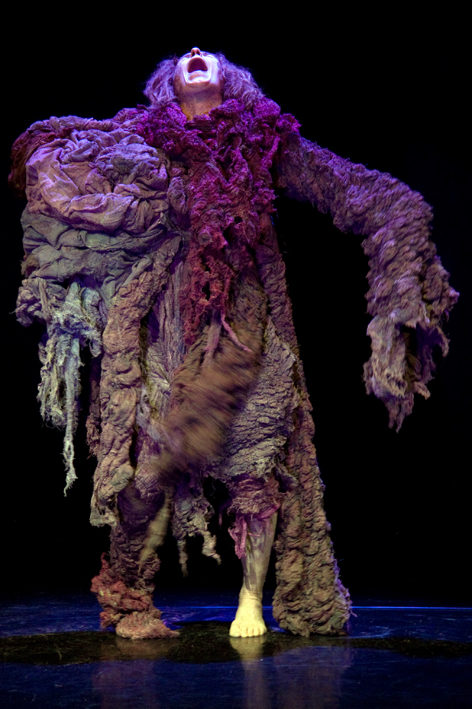
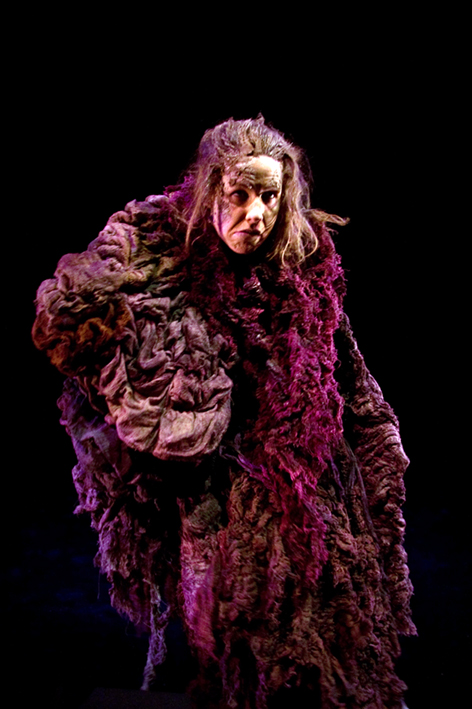
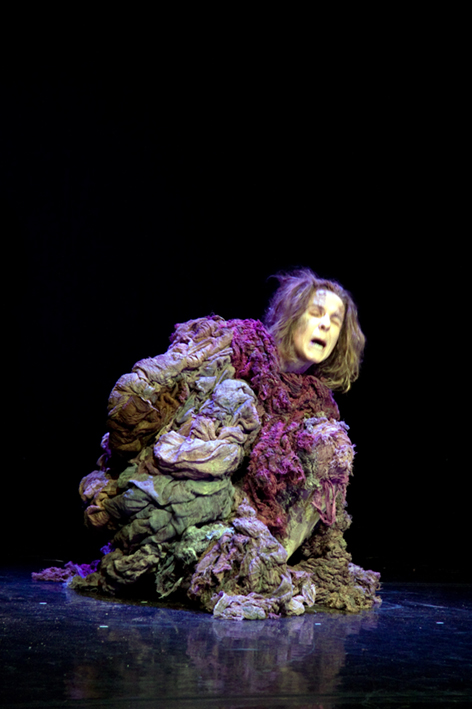
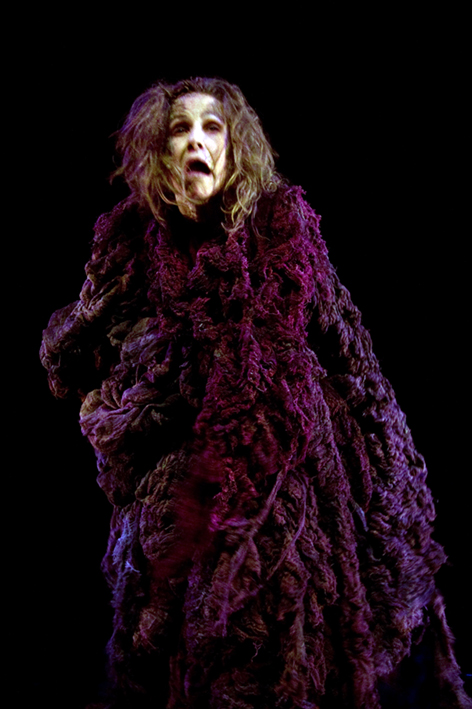
In January of this year, I completed my MA in
Costume Design for Performance at London College of Fashion. Our final 'exhibition' for this
was in the form of a performance piece at the Lilian Baylis Studios at Sadlers Wells, which
had been the culmination of six months of work on personal projects in collaboration with
performers, choreographers, and various theatre practitioners.
My performance piece focused on the character of the Skriker, a shape-shifting underworld
creature, from Caryl Churchill's play of the same name. Previously I spoke about some of the
research which I had undertaken in the development of my overall design ideas. Working out
of these ideas, the key elements in the creation of the Skriker became, for me, finding a
textile which would evoke an ancient creature, and a changeable silhouette, which would have
a feeling of age, and history, and perhaps give suggestions of historical costume.
The costume which I ended up with was intended to look ragged and decrepid, but also to be
able to be manipulated by the performer, to be at one moment menacing, at another regal animalistic
or fragile, changing and growing as the audience watched. It also had to be something which
would enhance the movements of my performer, without being too restrictive. What became an
asymmetrical, almost tumour-like mass of limbs came from ideas of having a ruff which had
exploded out into tubes which could become the limbs of the creature at one moment, inert
forms another. In finding ways of making such a structure, I looked in detail at how ruffs
of the sixteenth and seventeenth centuries were made, and translated techniques into forms
which would work for me, actually using scrolling net to make a hump shape on one side of
the costume, as a core for the 'limbs'. This was then combined with textiles I had graduallly
developed from earlier research and inspiration to create a crumbling form.
Ultimately, it was a hugely rewarding project to work on. I loved being able to undertake
a long period of research and development, and to be able to talk to different people, and
visit different institutions and collections to discover artefacts which changed and informed
my work as it grew. In creating such a strange and surreal character, I knew my costume was
not going to be recognisably historical, but I found that using my interests in period costume
gave more direction to the work. And in having additional funding, I was able to buy books
which became vital tools in developing textile techniques, and understanding historical costume,
as well as simply buying materials to work with, and travelling around visiting different
places and people for my work. Above all however, the project has left me with many more avenues
of research I would like to explore. I would like to thank the Costume Society for helping
make the entire project such a fulfilling experience for me, and for encouraging interests
which I am sure will continue to grow and develop for some time.
2008 Annalise Harvey
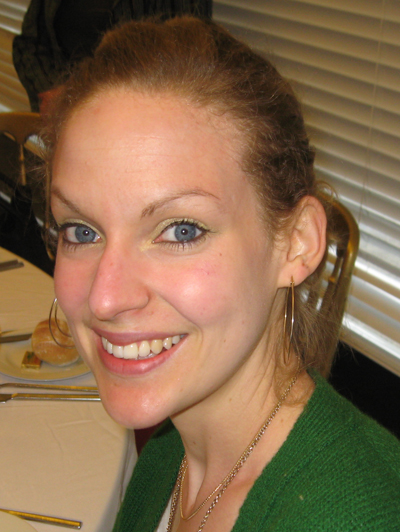
May 2008
What began as a simple investigation of the S-Bend corset of the early 20th Century ultimately
became an enlightening journey into form and structure. It took on a life of its own developing
into a short performance laboratory which raised and addressed questions of the 'ideal' silhouette.
Initially I had to hone down exactly what it was that I sought to focus on and having initially
made contact with Alison Carter at Hampshire Museums, she suggested I contact Ian Chipperfield,
also known as the Staymaker. Ian was an absolute fount of knowledge and very generously gave
up a good proportion of his time one evening in a delightful and enlightening debate about
the corset, its variations and its structure!
Following this my first archive visit was to
Hampshire museums and the collection in Winchester, lovingly maintained by the aforementioned
Alison Carter. It was my first visit to an archive of costume of any description and was a
real eye-opener. I found the afternoon I had there not nearly enough and I lost the hours
trying to work out how to communicate the 3 dimensional and highly engineered construction
onto a flat page. I took my research into the studio and recreated one of the corsets I had
seen in a basic calico toile.
In hindsight this was excellent preparation for my second archive
trip – to the Symington collection in Leicestershire. Philip Warren, Keeper of Cultural Life,
and his colleagues were hugely accommodating and informative and again it was joy to have
the privileged and hands-on access to such a wide variety of shapes. Having clarified in my
mind that it was the structure that was of real interest I looked in depth at two items, drew
them meticulously, and then translated this information into a calico toile back in the studio.
These 3 blocks then became the basis for development of a 'new' type of S-bend, which sought
to build upon the Edwardian principals of a curved construction to enhance the natural contours
of the body, whilst remaining highly restrictive. I created a fourth toile, playing with line
and proportion. This formed the pattern for the final realised corset.
Alongside this work,
as required by the syllabus of my MA at LCF I was developing ideas of how this corset could
be used in a performance context. Having worked in ballet for the past 5 years as a costume
designer I decided to work with a classical dancer, on pointe, to investigate the physicality
of the body as affected by the corset. In contrast to the classical silhouette I padded her
to be a living mannequin for the S-bend. The attached image illustrates the performance process.
This project was a fascinating journey which would never have been embarked upon had it not
been for the opportunities that the Costume Society, through the Yarwood Award, afforded me.
It has been an invaluable experience both personally and academically and has formed a strong
foundation on which to build my final Major Project due in Dec
I would like to extend my
sincere thanks to Alison Carter, Philip Warren, and Ian Chipperfield for their generous assistance
in the research process, and of course the Costume Society for making it possible.
2006 Kate Strasdin
Exploring a Royal Wardrobe:
Seven years ago, whilst working as an assistant to the curator at Killerton House
in Devon, the collection was contacted regarding a trunk full of old clothes in
a local house. This was not in itself an exciting occurrence but Shelley Tobin the
curator, went to investigate all the same. What she found there was, however, well
worth the trip. Bundled into the old trunk and locked in the attic of a small Victorian
Gothic mansion, were six beautiful gowns, all bearing the label of Redfern. This
was to become a significant discovery for me and the direction of my future studies.
On learning that Redfern had been a favoured couturier to Queen Alexandra, both
during her time as Princess of Wales and Queen Consort, I found myself looking out
for images of this elegant woman, of which there are many hundreds. This interest
which started as an idle gathering of photographs and cheap second hand biographies
grew still further on visiting the Royal Wedding Dresses exhibition at Kensington
Palace and so an obsession was born! I discovered that there were a number of surviving
garments relating to Queen Alexandra, and that although she is most often referred
to as a woman famed for her style and beauty, no comprehensive study has ever been
undertaken that looks in more detail at her life through dress. I decided to try
to view and catalogue as many of the objects as possible and it was at this point
in my early studies that I applied to the Doreen Yarwood fund.
The generous award that was made has allowed my research to progress immeasurably.
Living in Devon, access to the major collections in the UK, is more than just a
tube ride away, so I was able to make many visits over the course of the last year.
This included two trips to Windsor to access material in the Royal Archive; boxes
of wonderful photographs that illustrated just how much of a style icon Alexandra
became, as well as her own private journals relating to her many travels. It was
during the course of these visits that I discovered the existence of four volumes
of her wardrobe accounts covering the last years of Queen Victoria’s reign and the
whole of the Edwardian period which I will be able to study later this year.
A trip to Kensington Palace for an initial look at the garments held in the Royal
Ceremonial Dress Collection offered a wonderful opportunity to gain a three dimensional
sense of the woman beyond the photograph. Joanna Marschner very kindly took the
time to take out as many objects as I could easily view in one day, as well as sitting
down to chat about my research project for future visits.
Several days spent in the British Library Reading Rooms (one of my favourite places
in the world!) revealed a great deal through diaries and memoirs that would otherwise
have remained inaccessible without the assistance that the bursary gave. The piecing
together of Queen Alexandra’s wardrobe is truly bringing out the detective in me
since she ordered that all of her private papers, correspondence and other records
be destroyed on her death, which her faithful lady-in-waiting the Hon. Charlotte
Knollys carried out almost to the letter. Therefore, it requires a great deal of
lateral reading to gain an insight into Alexandra and her clothing choices through
the writings of her contemporaries, periodical reports and the garments themselves.
The Doreen Yarwood bursary has enabled me to meet the not inconsiderable costs of
contacting as many museums as possible, both national and international, in order
to try and find as much extant material as possible. This has yielded some positive
results so far from 25 items of clothing in the Metropolitan Museum in New York,
several items in Japan, three pairs of shoes in Australia, two outfits in Norway
and the whereabouts of another forty currently under examination in addition to
the holdings in the UK. The long term aim of this is to produce a comprehensive
database of all of Queen Alexandra’s garments worldwide culminating possibly, in
an exhibition celebrating her life through dress.
Perhaps as a fitting postscript, there has been a further exciting development in
the progress if this research, thanks largely to the award made. The proposal that
I made to the Textile Conservation Centre at the Winchester School of Art to pursue
this study as an MPhil/PhD project was accepted and I am now well into my first
year of work with Dr Maria Hayward and Barbara Burman as supervisors. It has been
an exciting twelve months for me. What began as a chance discovery in an attic has
led to a long held wish to embark upon a PhD. I have to thank the Costume Society
and the Doreen Yarwood Award for helping me get there.
2005 Lindsey Sarah Holmes
The Award for 2005 was granted to Lindsey Sarah Holmes (nee Woodgate) from Peterborough.
Lindsey is a volunteer working with the Wisbech and Fenland Museum in Wisbech. Here
is her report.
The aim of my research was to improve knowledge of the costume collection, assess
the conservation needs in the store and ultimately help the museum improve access
to the collection. The grant enabled me to not only to travel within Cambridgeshire
but also travel to other museums to seek advice. The project was completed over
one year.
The collection holds a broad range of men’s, women’s and children’s dress ranging
from items made by prisoners at the Wisbech prison to clothing worn by the rich
and successful Peckover family. Many items come from local people whose relatives
are still visiting the museum today. The collection also holds a broad range of
ethnic dress showing traditional costume and accessories from around the world many
of which have interesting provenance. In addition the museum holds a rare and interesting
collection of textiles which have now been recorded.
With the help of the award I visited the Victoria and Albert Museum and met Susan
North, costume and textile curator, who showed me their storage and discussed with
me the challenge of storing costume. I was able to photograph their storage as a
reference for the Wisbech museum. This trip was extremely helpful and, although
the space for storing costume at Wisbech is limited, we have, with the help of the
museum’s tireless staff and volunteers, been able to make improvements to our current
storage. I was also able to visit the Museum of Costume in Bath and, again, study
different methods of display and presentation.
The project has given me an invaluable opportunity to improve my costume identification
and conservation skills and has improved the access to costume at the Wisbech museum:
it is hoped that the collection will be made available on the Internet in the near
future.
Many of the exhibitions held at the museum in the last year have included items
of costume and the collection can now be viewed by appointment. I personally hope
to continue to work with historic costume and plan to start my MA later this year,
exploring further the place of costume within museum collections.
I would like to give my sincere thanks to the Costume Society and the Doreen Yarwood
Award for the chance it has give me and also my thanks to all at the Wisbech and
Fenland Museum who have worked so hard in helping me with this project. The research
experience so encouraged me that I have applied to and been accepted on the MA Costume
Design course at the London College of Fashion.
2003 Alessandra Kajdanska
In 2003 Alessandra Kajdanska of Gdansk, Poland, was granted the Yarwood Award. However,
Alessandra was not able to complete her research until 2005. A very detailed report
was submitted; this edited version was been prepared for the Newsletter .
Fashion and Style in 18th Century Gdansk As Reflected In The Work Of Daniel Chodowiecki
Daniel Chodowiecki was a remarkable 18th century artist born in Gdansk. He became
director of the Berlin Academy of Arts and was a prolific illustrator of books,
including the work of many English authors such as Oliver Goldsmith (Vicar of Wakefield),
John Milton (Paradise Lost) and Samuel Richardson (Clarissa Harlow). He illustrated
scientific and educational books and illustrated performances of Shakespeare’s plays
in Berlin such as Hamlet, Macbeth, The Tempest et cetera. Chodowiecki was also assiduous
in sketching everyday scenes observing occupational dress as well as fashionable
dress.
Gdansk was then a city open to people from many different nations. There are very
evident influences from the cultures of the Netherlands, Germany, Italy, France,
England and even the Orient. Many crafts flourished and the most important centre
for their manufacture was established by settlers from Scotland in the district
now known as Nowe Szkoty, New Scotland. There were furniture makers, weavers, tailors
and haberdashers. There were also close connections with the Elizabethan theatre.
English actors often came to perform in the city from 1615 in the specially reconstructed
Fencing School. Sadly, thanks to the many wars that have affected Poland, there
is little left of early costume.
My research led me to collect a rich portfolio of Chodowiecki’s drawings: I am particularly
interested in Gdansk costume of the second half of the 18th century. One of the
most important sources for costume is Chodowiecki’s diary Journey from Berlin to
Gdansk compiled in 1773 at what can be seen as the last moments of splendour in
the city.
108 illustrations reflect everyday life. Among them are portrayals of different
nationalities, religions, Gdansk aristocracy and working people. Details of costume
are closely observed.
The drawings can be divided into two groups. One represents people in their environment:
the other presents portraits. Research identifies many influences on dress. English
masculine fashion was obviously favoured by the professional classes, merchants,
artisans and some city officials whilst women’s dress is clearly influenced by French
as well as English style. Polish national costume is also in evidence for higher-ranking
men using oriental brocades, taffetas et cetera with a strong Turkish influence.